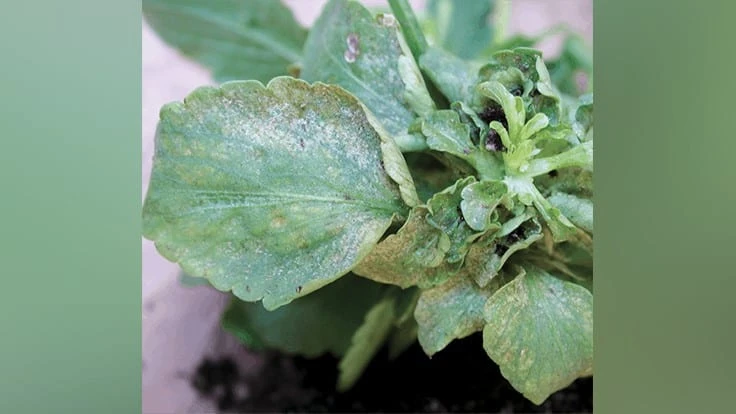

With the advent of new fungicides and pesticides available, it’s important for growers to take note of the options available to them. IRAC/FRAC (Insecticide/Fungicide Resistance Action Committees) provide growers with relevant pest control information and advice. With proper product rotation and new MOAs (mode of action), growers can keep pests and diseases at bay.
IRAC Groups
Daniel Gilrein, extension entomologist with Cornell Cooperative Extension of Suffolk County, is an expert in this field and often advises growers concerning the use of insecticides and miticides. Gilrein says the IRAC classifications are very helpful, particularly when targeting some pests and situations where there is a significant risk of resistance development, such as in greenhouse and nursery production of ornamentals.
Gilrein says there are a few things growers need to keep in mind when it comes to properly rotating insecticides. After the pest problem is identified where treatment is deemed necessary, he lists out a plan based on the following factors:
- The pest’s track record for development of resistance
- The history of what that pest population has been exposed to (as far as known)
- The size of the problem (i.e. is the pest population already high or still at an early stage of development)
- The pests’ stage(s) targeted (i.e. scale crawlers or mainly mites in the egg stage)
- Grower preferences (compatibility with biocontrols, the need for short re-entry interval, products already at hand, etc.)
- The crop to be treated and possible sensitivity (some insecticides shouldn’t be used on particular plants)
- Efficacy
- The application equipment being used
When pests develop a resistance, managing them becomes an extremely difficult task and may lead growers to have to discard a portion, or all, of their crops. “They must rotate chemistries and be proactive about managing resistance because some pests are notorious for developing insecticide- or miticide-resistant populations. Additionally, the population at hand may already have resistance to some materials,” Gilrein says.
“Rotating among different modes of action can reduce the risk of promoting resistance or maintaining resistance in a population that already has it. It is especially important for propagators to be aware of the issue, so resistant pests are not conveyed with plant material,” he says. “Also, we want to make sure insecticides and miticides will work when we need them, and they continue to be available and useful for a very long time; thinking of susceptibility as a kind of ‘natural resource’ we want to conserve.”
Enter diamide insecticides in IRAC Group 28, which differ from traditional chemistries. Nancy Rechcigl, technical services manager for ornamentals at Syngenta, shares why using diamides is a good option for growers.
“The active ingredients in this group selectively activate the ryanodine receptor in the insects’ muscles, causing the release of calcium ions,” Rechcigl says. “This results in paralysis and rapid inhibition of feeding and other key physiological functions. Insect feeding is typically stopped after initial ingestion, and insect mortality is observed within 2-7 days, depending on the pest.”

“Many insecticides in other IRAC groups affect different aspects of the pest’s nervous system, the diamides target a different site, making them a good rotational tool. This class of chemistry has also shown to be compatible with the use of beneficial insects and mites, which makes them an ideal partner in integrated pest management programs,” she says. “When plants are treated with a diamide and challenged with insect pressure, the plants are protected and the pests are not able to establish in the crop.”
For successful integrated pest management programs, growers should focus on preventive applications rather than curative, which is especially necessary when using biological controls, according to Gilrein. Managing the problem early is key, because gaining control later may be much more difficult, due to things like high pest populations, dense plant canopies and plants arranged or spread out that makes insecticide coverage difficult — and may require more material to get rid of the insects.
Rechcigl notes diamides can be used in curative applications for pests such as worms and leafminers, but preventive applications (when the pests are first observed) are best for controlling whiteflies, thrips and mealybugs.
“In addition to use as foliar sprays, some diamide insecticides have systemic activity when applied to soil, media or bark, and relatively few other insecticides have such systemic uses,” says Gilrein.
Mainspring® GNL and Acelepryn® insecticides from Syngenta are two diamide chemistries with systemic activity that act as shields to protect plants from a wide range of insects.
“While the mode of action of how they work is similar, the different active ingredients within the diamide class of chemistry differ somewhat in their pest spectrum and in their systemicity,” says Rechcigl. “While all diamides have translaminar activity, only cyantraniliprole (Mainspring GNL) and chlorantraniliprole (Acelepryn) can be applied as a foliar or bark spray or as a drench for long, systemic protection.”
FRAC Groups
Margery L. Daughtrey, senior extension associate at Long Island Horticultural Research & Extension Center at Cornell University, shares why it’s important to properly rotate fungicides. She says diseases with rapid epidemic development and prolific pathogen sporulation, such as Botrytis blight, downy mildews and powdery mildews, are the ones where it is most important to practice fungicide rotation — and is critically important for crops being cultivated in greenhouses.
She notes key resources are the information on the product label (where the FRAC group is always given) and the FRAC website itself, which updates listings every year.
“The main danger is that you think you are rotating properly when in reality you’ve followed one fungicide application with another one from the same FRAC group — which means they will have the same mode of action, even though the product name and the fungicide’s common name might sound quite different,” Daughtrey says. “Strobilurin fungicides, for example, they are all in FRAC Group 11, so there is no point to treating twice with Heritage and then ‘rotating’ to treat twice with Compass. You’ll be exposing the fungus population to the same weapon by a different name, and you will be encouraging strobilurin resistance in the fungus population.”
With the help of 11+7 fungicides, like Mural® from Syngenta, growers can be sure they are using an effective management method.
The combination of two highly effective and broad-spectrum fungicide modes of action — an SDHI (succinate-dehydrogenase inhibitor) fungicide paired with a strobilurin — will slow resistance development to a pathogen that happens to be susceptible to both, she says.


“Using contact action materials at low or no danger of resistance development during periods when the environment is not highly conducive to disease, or alternating them with 11+7 materials, is a good strategy.” — MARGERY L. DAUGHTREY, senior extension associate at Long Island Horticultural Research & Extension Center at Cornell University
“An 11+7 material will help you to cope with leaf spots, powdery mildews, downy mildews and rusts,” she says. “And you are likely to be getting some systemic action against the pathogens.”
Daughtrey notes growers shouldn’t rotate an 11+7 or an 11+3 fungicide with an 11 fungicide. This is due in part from the perspective of the tiny fungus growers want to manage. It will see continuous 11s, and growers will thus increase the selection pressure, so the strobilurin component will become ineffective sooner, she says.
“Using contact action materials at low or no danger of resistance development during periods when the environment is not highly conducive to disease, or alternating them with 11+7 materials, is a good strategy,” she says, “Learn which fungicides work best against the problems your crops are subject to, and deploy them strategically, keeping in mind the need for thoughtful fungicide rotation.”
The key attribute that makes Mural an ideal choice for growers is due in part to its translaminar and systemic activity, but also because it is xylem mobile.
“When applied as a drench for protection against root and crown rots, Mural will move upward into the plant canopy to provide protection against certain foliar diseases, such as rusts and some powdery mildews,” says Rechcigl. “It is very useful for protecting daylilies or ornamental grass crops against rust, with one drench application providing six to eight weeks of protection.”
Mural also provides good control/suppression of Pythium spp. and offers plant health benefits. Increased root density has been routinely observed with drench applications using 2-3 ounces and foliar sprays applied at rates of 4-5 ounces.
ROTATION COMBATS RESISTANCE
When it comes to proper rotation, Rechcigl says a robust resistance management program should include a rotation of products from at least three to four different classes of chemistry (three to four different IRAC and FRAC Codes) for each pest or disease target. For fungicides, growers should make one or two applications of the same product (if the label allows) before rotating to a different class of chemistry. Insecticide/miticide applications should target the life cycle of the pest.
“Being good stewards and preventing resistance from developing allows the grower to have more options and tools in their management toolbox. Research and development activities for the discovery of new active ingredients with new and different modes of action takes time, often 10 to 12 years, and requires a significant investment in time and resources,” Rechcigl says.
Syngenta has developed several agronomic programs with built-in resistance management strategies. They are available for download here.

Explore the July 2020 Issue
Check out more from this issue and find your next story to read.
Latest from Greenhouse Management
- Pennsylvania Horticultural Society announces 2025 Gold Medal Plant winners
- GIE Media Horticulture Group wins five regional 2025 Azbee Awards of Excellence
- Terra Nova Nurseries introduces rust-free and disease-resistant heucherella
- John T. Nickel, founder of Greenleaf Nursery Co., passes away at 89
- Three tours offered at 2025 Farwest Show
- Garden Media Group announces sixth annual Women in Horticulture Week
- Star Roses and Plants announces National Knock Out Rose Day
- The Growth Industry Episode 4: How federal budget cuts are affecting horticulture nonprofits





